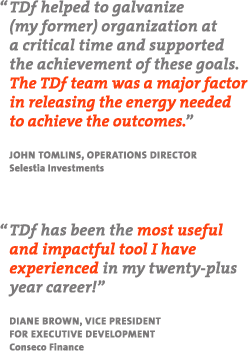The top managers responsible for e-commerce at a major
technical services corporation asked TDF International to help with
problems hindering a smooth interface between the different technical
groups involved in the effort.
Following interviewing, TDF International identified three key issues:
- Process problems
- A blame culture
- Communication difficulties throughout the entire
e-commerce group
TDF International suggested a Continuous Improvement Group, whose members would be a step below the top managers. We hoped that this break from the top-down style of this organization would itself be a major step forward. Rather than top-management directing changes, the CIG would empower staff to identify and solve problems. Problems are best solved by the people closest to them. A TDF International consultant facilitated and advised the meetings of this new group. At its first meeting, the CIG decided to focus on the following:
- Documenting work processes
- Planning crisis management
- Coordinating planning between groups
- Reversing the blame culture
The CIG focused on building a structure to bridge the internal tensions
between speed, quality, and cohesion. This structure emphasized stronger
quality assurance testing, to deal productively with the roots of
the blaming.
- "Using the Task Force model is the way to go; it gets more people involved and the solutions are better, and people stop complaining about problems because they are involved in fixing them"
- "Teams are beginning to reach out to each other. It's a good start"
- "People are thinking more before they start to blame"
The key has been to see that the problems are not just technical. The problems are human, as well, and the solutions will also have to be human.













